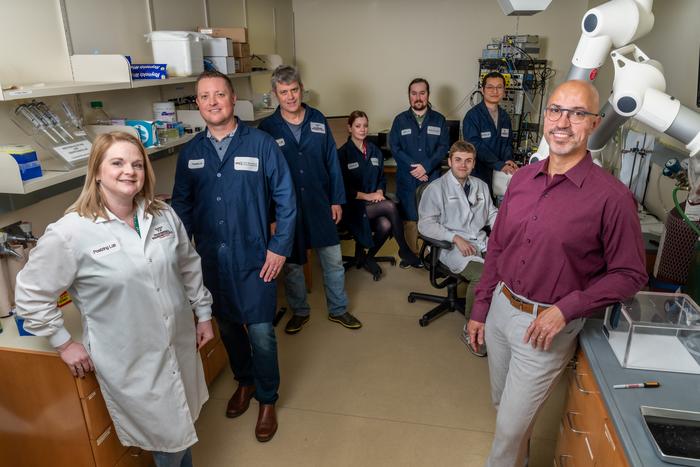
In a groundbreaking study that challenges longstanding assumptions about the aging heart, researchers at Virginia Tech’s Fralin Biomedical Research Institute have unveiled microscopic adaptations within cardiac tissue that may serve to protect against arrhythmias, potentially revolutionizing our understanding of age-related cardiovascular health. Traditional perspectives have often viewed all structural changes in the heart with age as deleterious, yet this new research illuminates a subtle but critical biological mechanism where the narrowing of a tiny intercellular space works to maintain the heart’s electrical stability, thereby mitigating the risk of irregular heart rhythms.
Arrhythmias, or irregular heartbeats, are a prevalent concern among the elderly, often associated with increased morbidity and mortality due to their links with stroke, heart failure, and sudden cardiac death. Among the most common forms is atrial fibrillation, impacting millions worldwide and placing a significant clinical burden on healthcare systems. Conventional wisdom has held that the aging process inherently compromises cardiac function, increasing vulnerability to these rhythm disturbances. However, the study led by Steven Poelzing, James and Deborah Petrine Professor of Biomedical Engineering and Mechanics, disrupts this narrative by demonstrating an intrinsic compensatory mechanism at the cellular level.
Central to this discovery is the perinexus, a nanoscopic space adjacent to gap junctions in cardiac myocytes, which plays an essential role in electrical coupling and conduction between heart cells. Using sophisticated experimental models involving both young and aged guinea pig hearts, Poelzing’s team meticulously observed how this intercellular gap responds to age. Remarkably, they found that as the heart ages and cardiac cells enlarge, the perinexus naturally narrows. This structural remodeling appears not only to be benign but functionally adaptive, effectively enhancing the robustness of electrical signaling across heart cells.
To better understand this phenomenon, the researchers induced sodium channel gain-of-function conditions pharmacologically, a manipulation known to predispose hearts to arrhythmogenic activity through increased sodium ion influx and altered action potential propagation. Their observations were striking: aged hearts with a constricted perinexus resisted developing arrhythmias despite the chemical provocation, while artificially widening this gap made the same aged hearts highly susceptible to erratic electrical activity. Younger hearts, possessing inherently wider perinexal spaces, did not exhibit this protective effect and remained stable under identical conditions.
This compelling evidence suggests that as cardiac myocytes grow larger during aging, their tighter physical adherence, facilitated by the narrowed perinexus, maintains electrical synchronization and countervails the destabilizing tendencies brought on by sodium channel dysregulation. Poelzing metaphorically compared the perinexus’s role to that of a house’s foundation — a crucial structural base that determines the overall resilience of the system. If this microstructure remains intact and robust, underlying vulnerabilities elsewhere may remain hidden, thereby concealing signs of cardiac pathology that would otherwise manifest clinically.
The clinical implications of these findings extend beyond simple biological curiosity. They provide a potential explanation for the “concealed” nature of certain arrhythmias in elderly patients—pathologies that evade detection during standard diagnostic testing because the heart’s adaptive mechanisms transiently restore normal electrical function. Such insights underscore the importance of comprehensive, long-term cardiac monitoring in older populations to capture intermittent arrhythmic events before they resume stabilization through physiological compensation.
Moreover, the study opens promising avenues for targeted therapeutic strategies centered on the modulation of the perinexus. By understanding and manipulating its size and function, future interventions could reinforce the heart’s natural defenses against arrhythmia development, especially in the context of aging and sodium channelopathies. This delicate “push-and-pull” balance, as emphasized in an accompanying editorial in the same journal, represents a finely tuned mechanism that dictates cardiac electrophysiological homeostasis.
From a bioengineering standpoint, translating these findings into clinical practice will require innovative approaches to measure and influence the nanoscopic architecture of cardiac tissue in vivo. Techniques such as super-resolution microscopy, molecular probes, and computational modeling of ion channel dynamics are pivotal tools that will facilitate this leap. Concurrently, pharmacological approaches that preserve or enhance cellular adhesion and perinexal integrity may emerge as adjunctive therapies complementing existing antiarrhythmic regimens.
The fundamental revelation that age-related perinexal remodeling can confer a protective effect also invites a revision of how cardiovascular aging is conceptualized within both research and clinical paradigms. Rather than viewing all morphological changes as pathological, there is now a compelling case for recognizing adaptive remodeling processes that sustain cardiac function under the inevitable stresses of aging. Such a perspective brings a nuanced understanding that could influence risk stratification, patient management, and even the development of personalized medicine strategies in cardiology.
This study also highlights the vital role of cross-disciplinary collaboration in unraveling complex physiological questions. The convergence of experimental cardiac electrophysiology, cellular biology, and engineering mechanics has enabled the detailed characterization of the perinexus’s role in heart function, illustrating the power of integrative research approaches. Additionally, the use of guinea pig models, which share significant electrophysiological similarities with human hearts, bolsters the translational potential of these findings.
In summary, the work spearheaded by Poelzing and colleagues challenges the dogma that all age-associated cardiac changes compromise heart health. Instead, by revealing the natural narrowing of the perinexus as a compensatory mechanism to maintain electrical communication and prevent arrhythmias, this research paves the way for a transformative understanding of cardiac aging and its management. As the global population continues to age, such insights are critically important for developing therapies that extend not only lifespan but the quality of life free from debilitating cardiac rhythm disorders.
Subject of Research: Cells
Article Title: Age-Associated Perinexal Narrowing Masks Consequences of Sodium Channel Gain of Function in Guinea Pig Hearts
News Publication Date: March 5, 2025
Web References:
DOI: 10.1016/j.jacep.2024.12.027
Image Credits: Clayton Metz/Virginia Tech
Keywords: Health and medicine, Biomaterials, Cardiac arrhythmias, Cell biology
Tags: advancements in biomedical engineering for heart healthaging heart adaptationsarrhythmias in elderly patientsatrial fibrillation prevalencecardiovascular health innovationscompensatory mechanisms in heart agingelectrical stability in aging heartimplications of arrhythmias on healthmicroscopic changes in cardiac tissuerisk reduction for irregular heartbeatsunderstanding age-related cardiovascular changesVirginia Tech Fralin Biomedical Research Institute study





